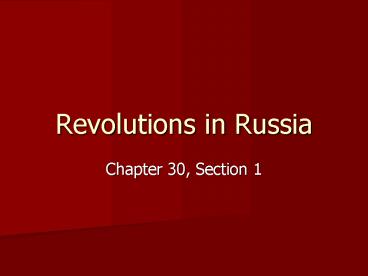Revolutions in Russia - PowerPoint PPT Presentation
1 / 33
Title:
Revolutions in Russia
Description:
Revolutions in Russia Chapter 30, Section 1 Introduction The Russian Revolution was like a firecracker with a very long fuse. The explosion came in 1917, yet the fuse ... – PowerPoint PPT presentation
Number of Views:173
Avg rating:3.0/5.0
Title: Revolutions in Russia
1
Revolutions in Russia
- Chapter 30, Section 1
2
Introduction
- The Russian Revolution was like a firecracker
with a very long fuse. The explosion came in
1917, yet the fuse had been burning for nearly a
century. The cruel, oppressive rule of most
19th-century czars caused widespread social
unrest for decades. Army officers revolted in
1825. Secret revolutionary groups plotted to
overthrow the government.
3
- In 1881, revolutionaries angry over the slow pace
of political change assassinated the
reform-minded czar, Alexander II. Russia was
heading toward a full-scale revolution.
4
Czars Resist Change
5
End to Reform
- In 1881, Alexander III becomes czar and ends the
reforms of his father, Alexander II. - Alexander III institutes autocratic rule,
suppressing all opposition and decent.
6
Czars Continue Autocratic Rule
- Government censors written criticism secret
police monitor schools - Non-Russians living in Russia are treated harshly
7
Anti-Jewish Pogroms
- Jews become target of government backed pogroms
(organized persecutions) - Alexander III encourages Jewish emigration to the
United States during this time. The musical
Fiddler on the Roof is set in this era.
8
- In 1894, Nicholas II becomes czar and continues
autocratic ways
9
Russia Industrializes
10
Rapid Industrialization
- Number of factories doubles between 1863 and
1900, but Russia still lags behind other European
countries. - In late 1800s, new plan boosts steel production
and a major railway begins
11
The Revolutionary Movement Grows
- Industrialization breeds discontent over working
conditions and wages. - Growing popularity of Marxist idea that
proletariat (workers) will rule - BolsheviksMarxists who favor revolution by a
small committed group
12
Lenin
- LeninBolshevik leaderan excellent organizer and
inspiring leader
13
Crisis at Home and Abroad
14
The Russo-Japanese War
- Defeat in the Russo-Japanese War in the early
1900s causes unrest in Russia.
15
Bloody Sunday The Revolution of 1905
- In 1905, 200,000 workers march on the czars
palace to demand reforms - The army fires into the crowd, killing many
- Massacre leads to widespread unrest Nicholas if
forced to make reforms
16
The short lived Duma
- The Duma, Russias first parliament, meets in
1906 - Czar is unwilling to share power, dissolves the
Duma after only 10 weeks
17
World War I The Final Blow
- Heavy losses in World War I reveal governments
weakness - Nicholas goes to war front Czarina Alexandra
runs government in his absence
18
- Czarina falls under the influence of Rasputina
mysterious holy manwho she believes has the
power to heal her son. - Nobles fear Rasputins influence and murder him
- Army losing effectiveness people at home are
hungry and unhappy
19
The March Revolution
20
First Steps
- In March 1917, strikes expand soldiers refuse to
fire on workers. - Most of the tension is caused by Nicholas II
personally taking command of the military in
World War I, and the war going so badly.
21
The Czar Steps Down
- March Revolutionprotests become uprising
Nicholas abdicates throne - Duma establishes provisional, or temporary
government - Sovietscommittees of Socialist
revolutionariescontrol many cities
22
Lenin Returns to Russia
- In April 1917, Germans aid Lenin in returning
from exile to Russia (pictured in disguise with
his goatee shaved and wearing a wig).
23
The Bolshevik Revolution
24
The Provisional Government Topples
- In November 1917, workers take control of the
government
25
Bolsheviks in Power
- Lenin gives land to peasants, puts workers in
control of factories - Bolsheviks sign treaty with Germany Russia pulls
out of World War I
26
Civil War Rages in Russia
- Civil War between Bolsheviks Red Army and
loosely allied White Army - Red Army wins three-year war that leaves 14
million dead
27
Comparing World Revolutions
- Russian and French Revolutions are similarboth
attempt to remake society and use violence
against citizens who resist these changes.
28
Lenin Restores Order
29
New Economic Policy
- In March 1921, Lenin launches New Economic
Policy has some capitalism - NEP and peace restore economy shattered by war
and revolution - By 1928, Russias farms and factories are
producing again
30
Political Reforms
- Lenin creates self-governing republics under
national government - In 1922, country renamed Union of Soviet
Socialist Republics (U.S.S.R.) - Communist Partynew name taken by Bolsheviks from
the writings of Marx
31
Stalin Becomes Dictator
32
A New Leader
- Trotsky and Stalin compete to replace Lenin after
Lenins death - Joseph Stalincold, hard Communist Party general
secretary in 1922
Leon Trotsky
Joseph Stalin
33
- Stalin gains power from 1922 to 1927
- Lenin dies in 1924
- Stalin gains complete power in 1928 Trotsky is
forced into exile. - Trotsky is murdered in Mexico City in 1940 by an
NKVD agent.
Room where Trotsky was murdered (above)
Trotskys murderer, NKVD agent, Romón Mercader
(right).































